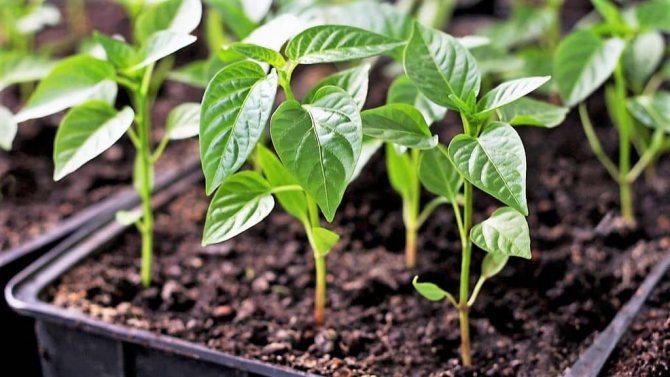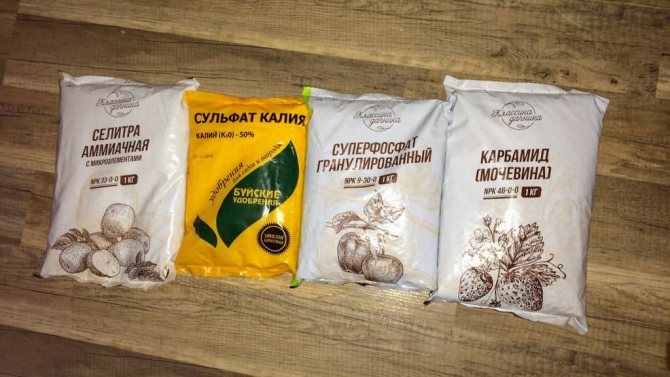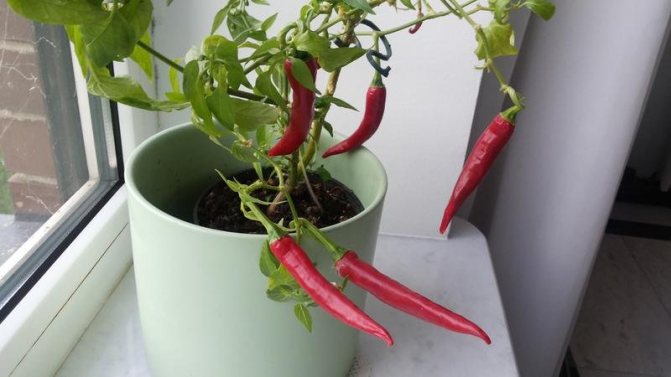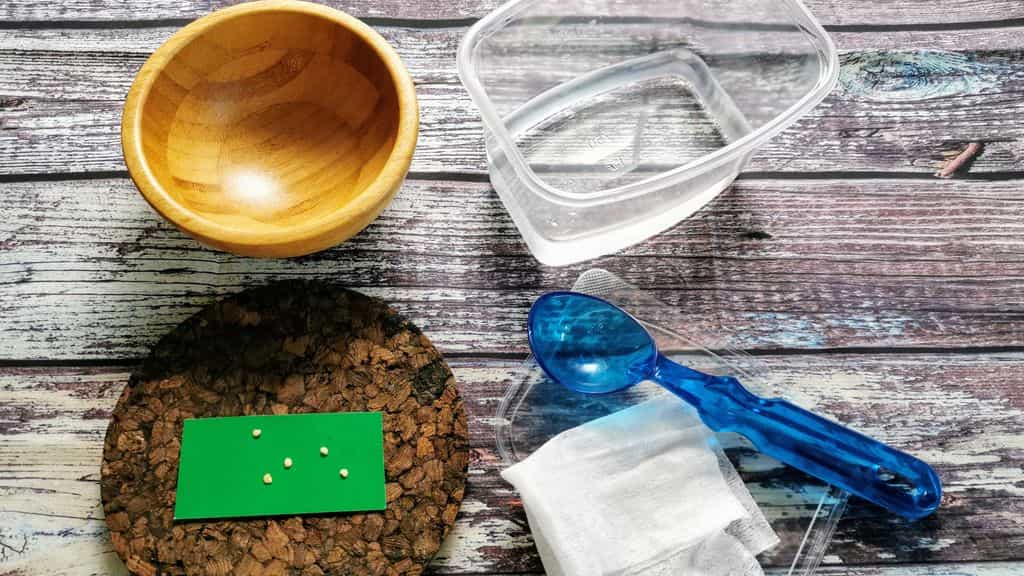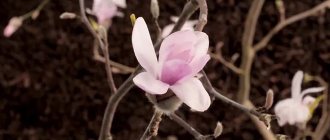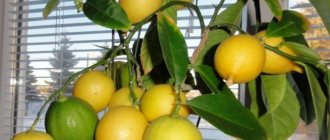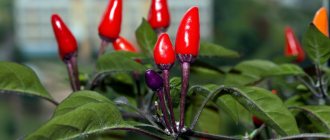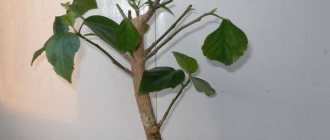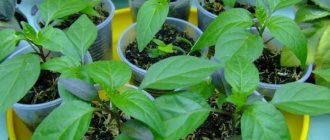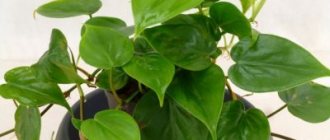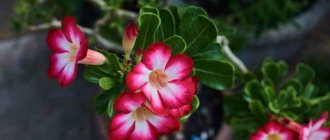Description of the variety
Pepper variety Ogonyok is a perennial herb native to Mexico. It was obtained by direct crossing of the sharp Chilean and Cayenne varieties. Today, the fruit of the plant is considered one of the most common additives to cold and hot dishes.
The main characteristics of the variety:
- type - shrub species, with a pyramidal structure of the bush;
- purpose - ornamental fruit plant;
- the total height can be up to 40 cm;
- the plant belongs to mid-season crops, 115-125 days pass from the beginning of germination to ripening of fruits;
- leaves are small or medium in size, rich green hue, slightly wrinkled;
- under optimal conditions, it can bear fruit for 5-6 years;
- the variety is grown both in open soil and on a windowsill;
- the culture is resistant to a variety of bacterial, fungal infections, as well as verticillary wilt;
- plants are resistant to changes in conditions of detention, as well as microclimate;
- the bush does not require a garter;
- yield - high, one plant gives about 100 fruits per year;
- yield from 1 m² is 3.5–4 kg;
- fruits are small, elongated, pod-shaped, slightly curved at the end, up to 5 cm long, up to 3 cm wide;
- the color of the fruit depends on the stage of ripeness: young peppers are bright green, ripe peppers have a deep red color;
- the average weight of one fruit is in the range of 35–45 g;
- the taste of the fruit is spicy, rich, with a bright aroma and peppery aftertaste;
- peppers are characterized by an increased content of trace elements, vitamins and aromatic substances;
- fruits are used in raw, dried form, and also canned separately, or in combination with other vegetables;
- the variety is ideal for home use as well as for sale.
Did you know? Spicy varieties of pepper came to European culture thanks to the expeditions of Christopher Columbus. In addition, it was this discoverer who gave the world-famous name "chili" to the capsicum.
Rules for caring for hot pepper in an apartment
Watering and spraying
The frequency of watering Chili and Spark peppers depends on the air temperature in the house and the volume of the pot. Even small plants are watered more often, since they grow in small containers with a small amount of soil, which dries quickly. Adult bushes are watered less often. But in any case, watering should be regular, immediately after the topsoil dries out.
After about 30 minutes, you need to see if there is any water left in the pan. During this time, the roots are saturated with moisture and excess water must be drained. Otherwise, the root system will start to rot.
Hot peppers are watered only with settled water at room temperature. The use of cold water is stressful for the plant, which can lead to leaf fall and various diseases.
The leaves should be sprayed if the air in the apartment is dry. Be sure to spray the foliage in winter and at other times of the year, when heating radiators are working. For spraying, water at room temperature is also used.
Bush formation
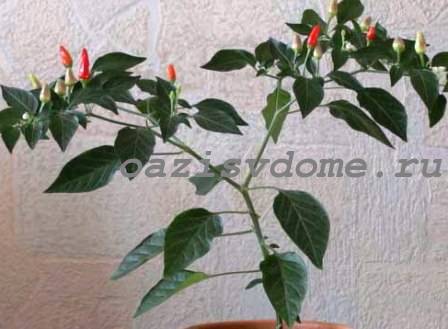
Hot pepper bushes do not require special formation. To achieve tillering, you can simply pinch the top.Hot showers also contribute to the emergence of new shoots. To carry out this procedure, the water is filtered, heated to 45 degrees and watered so that hot water gets on the foliage.
New buds will form faster if you pinch off the very first bud.
Top dressing
Freshly transplanted Spark or Chili peppers are not fed for the first two months, since there are nutrients in the soil.
It will be interesting for you to know: How to grow snapdragon from seeds, sowing dates, photos
In the spring, when the plant is gaining green mass, fertilizers are used for feeding, which include more nitrogen. In summer, top dressing is done with complex mineral fertilizers with phosphorus and potassium. Fertilizers are applied every 7-10 days.
If the pepper does not want to bloom in any way, pay attention to the composition of the fertilizer. The increased nitrogen content leads to the formation of new shoots and foliage growth. In this case, the plant will not bloom. An urgent need to change the top dressing, which should contain potassium and nitrogen.
Harvesting the harvest
The ripening period of hot peppers on the windowsill depends on the variety. As soon as the fruits turn red, they need to be picked. Timely harvesting of ripe peppers will lead to the appearance of new buds on the bush. As a result, flowering and fruiting will be uninterrupted.
Advantages and disadvantages
This fruit crop was loved by gardeners due to its many useful properties.
- The main ones are:
- the ability to grow both in the garden and on the windowsill;
- high decorativeness;
- increased productivity;
- the ability to bear fruit throughout the year (indoors);
- due to the complex of important vitamins and minerals, the fruits have a beneficial effect on human health.
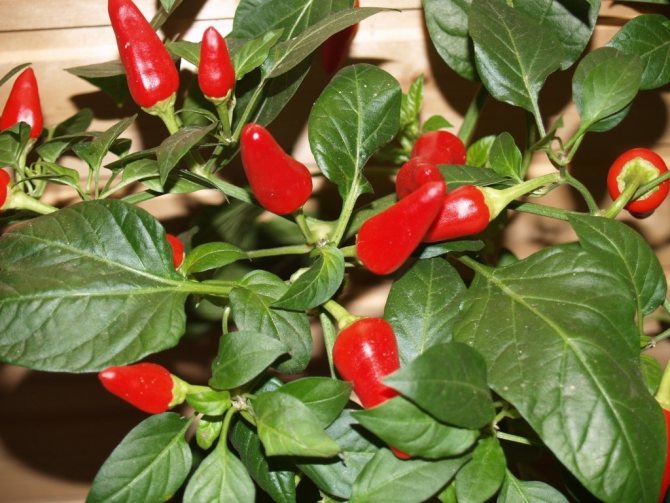

- Fire is not devoid of shortcomings - first of all, the following applies to them:
- low resistance to direct sunlight;
- yield directly depends on the conditions of detention;
- the variety does not tolerate heat, as well as low temperatures;
- when grown in a greenhouse, the plant requires constant regulation of temperature, light and humidity.
Did you know? Capsicum was not always hot - this property arose in him in the process of evolution, as a defensive reaction. Thus, the plant scares off animals, in the stomach of which its seeds gradually decompose, which impairs the ability to reproduce.
Diseases and pests
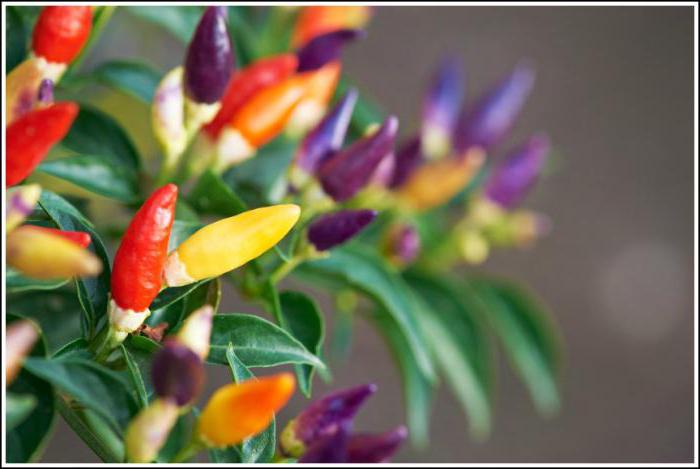

This is how the Spark pepper is grown on the windowsill. Caring for him is relatively uncomplicated. Moreover, his diseases do not strike him often. If the air in the room is too warm and dry, aphids can attack the plants. You need to fight it with insecticides. This can be, for example, Fitoverm or Agromertin. You can use these funds no later than two weeks before harvest.
Fire pepper is a very hardy and resistant plant. It contains capsaicin, which is often used in the fight against all sorts of pests, so it cannot be easily overcome.
If the leaves of the plant turn pale or completely fall off, then you should not immediately panic and think that the pepper is sick or has become a victim of some pests. He may simply not have enough daylight, and he decided to go into a state of sleep. As the day increases, the plant will return to normal, or it can be helped by providing artificial lighting.
As for pests, the lovers of this kind of delicacies include spider mites and aphids. The chances of catching these parasites increase in those plants that first grew in the garden, and then moved to the window.
Spider mite on pepper Fire
To prevent the pepper from becoming a victim of a spider mite, it will be enough to maintain the humidity of the air. Since the tick loves a dry climate, regular spraying, as if it will be scared away.
Pepper light is a plant that will not leave indifferent any housewife, because who does not like to have a beautiful and healthy harvest on their windowsill all year round.
Benefit and harm
- The main beneficial properties of pepper:
- improves the work of the cardiovascular system;
- reduces the amount of cholesterol in the blood;
- normalizes metabolism;
- reduces pain in headaches;
- relieves intestinal inflammation;
- helps to eliminate pathogenic microflora in the digestive tract;
- helps prevent colds and acute respiratory infections;
- saturates the body with a huge amount of vitamins and minerals.
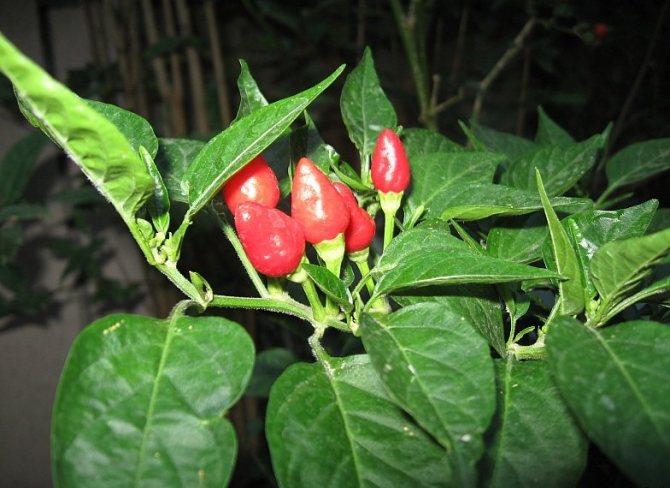

Despite the enormous benefits for the body, this vegetable can be harmful.
- First of all, he:
- irritates the mucous membranes;
- aggravates the course of arrhythmia and angina pectoris;
- leads to burns of damaged tissues of the stomach and intestines;
- during pregnancy can cause hypertonicity of the uterus.
How to plant peppers at home from seeds
To germinate pepper seeds on the windowsill will require a minimum of skills and knowledge, but to get healthy and fruit-bearing sprouts, you will have to try. The culture is thermophilic, therefore, for its development, an optimal temperature regime and humidity will be required, without which it is almost impossible to achieve high yields.
Sowing dates
Often, sprouting of pepper seeds begins in early spring; the most suitable period is late February - early March. Such seedlings will successfully begin to bear fruit by mid-summer, which in the southern regions allows it to be grown in open soil. If you grow a plant on a windowsill, you can germinate seeds at any time of the year. However, in this case, it must be borne in mind that seed germination will decrease significantly.
Growing features
Growing Pepper Seeds at home includes many planting and care features. Find a warm, well-lit place for the plants.
To plant a Spark, you need to buy seeds and stock up on plastic cups. In order to avoid mistakes, planting and maintenance should be done according to the instructions. Only in this way will the plant delight its owner with useful spicy fruits.
Sowing
Having decided to plant this variety, you need to prepare the soil mixture. Peat, turf land and leaf land are used (in equal proportions). You should also add 4 parts of the sand. The obtained seeds of this variety are soaked in water to dispose of empty planting material.
Seed sowing is forecasted for early spring. The planting itself is carried out in moist soil. The seeds are placed in the ground to a depth of no more than 1 cm, after which the cups are removed to a warm place and wait for the emergence of seedlings. From the moment of planting to the appearance of shoots, no more than 14 days pass.
Transfer
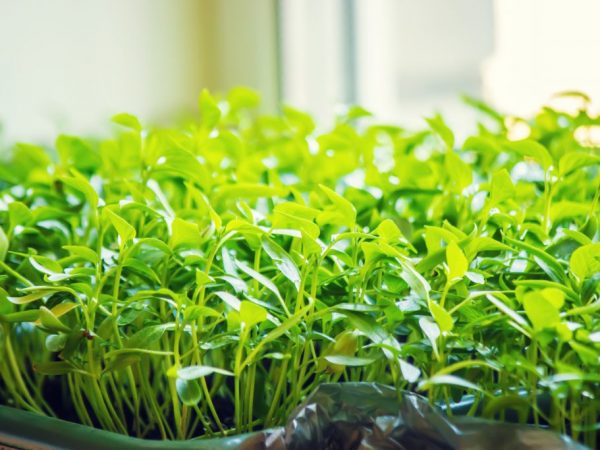

Good seedlings
This procedure is performed when the first pairs of leaves appear on the shoots. Small pots with an equipped drainage system are used.
Stages:
- It is necessary to prepare the soil and pour it into the pot. Sand, soda earth and humus are mixed in a 2: 1: 1 ratio.
- The sprouts are carefully removed from the cups and placed in the pots.
- The roots of the plant are sprinkled with a small layer of earth, which is later sprayed with warm water.
After transplanting, the shrub is harvested in a warm, well-lit place. It is recommended not to change the location of plants for 10-14 days, as the culture takes a long time to adapt to new conditions for itself. Further culture transplantation is carried out no more than 1 time in 2 years.
Place of cultivation
The most favorable place for growth and fruiting in an apartment is the sill of the southwest or southeast window. The plant needs to receive a lot of sunlight, and the temperature should be between 19-24 ° C.
In winter, it is better to place the pots away from radiators. They harm the plant by breaking the temperature regime and drying the air.
Further care
After the young peppers have taken root, it is imperative not only to create an optimal microclimate, but also to observe the general agricultural technique for growing indoor crops - a regulated regime of watering, dressing and additional care. This will help to insure to the maximum against a low yield, as well as all kinds of infections.
Lighting
Variety Ogonyok refers to light-requiring, therefore, for high yields, it will be necessary to create conditions for the plant with intense diffused light. The average daily daylight rate for this culture is within 10-12 hours, so in winter flowerpots must be illuminated. With a lack of light, the pepper can begin to wither, which not only has a detrimental effect on the foliage, but also leads to the falling off of even formed fruits.
Important! During artificial lighting, the lamps should be at least 30 cm away
from the plant, otherwise the foliage will get burned.
Temperature regime
The optimum temperature for growing a crop is considered to be + 20 ° C ... + 25 ° C. In summer, the plant can withstand heat up to + 30 ° C, but at the same time it must be shaded, as well as double the amount of watering. In winter, peppers are kept at + 16 ° C ... + 20 ° C - lower temperatures are undesirable for them, as they lead to depression and wilting.
Pollination
Although the Ogonyok variety is considered a fruit and ornamental plant, at home it is able to pollinate independently without the outside help of a gardener. Cross-pollination is extremely important for the yield and aroma of the fruit, therefore, in order to avoid a decrease in the quality of the future harvest, peppers must be pollinated during the flowering period. To do this, you need to carefully transfer pollen from one flower to another.
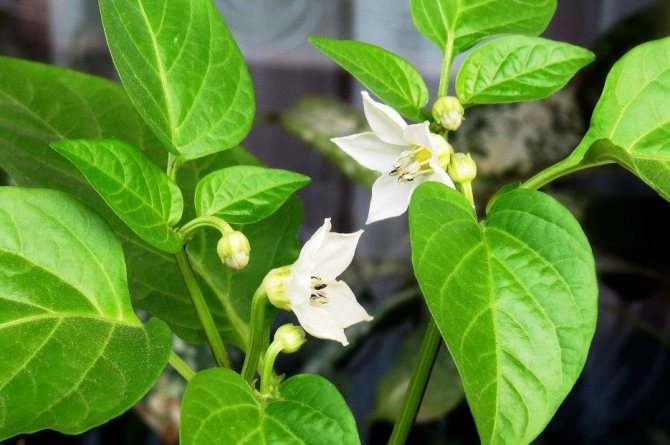

The procedure is carried out using a small brush: with one end of it, you need to smoothly draw one flower at a time, and then along the neighboring, most distant one. Thus, you need to expose each flower, involving the maximum number of them in the process. If you have 2 or more pepper bushes, pollination is carried out between neighboring plants.
Watering
Watering plants is carried out often, but in small portions. The fire does not like sudden changes in moisture, therefore, for abundant fruiting, it needs to create a moderate humidity regime: for this, the flowerpots are watered once every 1-2 days, as the soil dries. A clear indication of the peppers' need for water is a small dry crust on the soil surface.
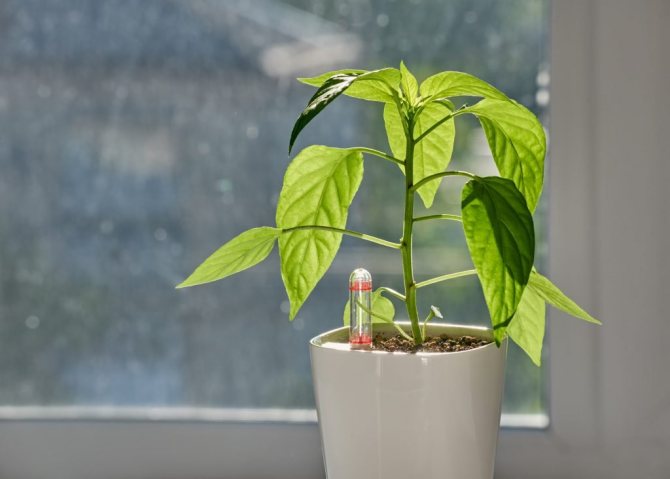

Top dressing
For the first time, young peppers are fed 2-3 weeks after planting in a permanent pot - by this time they will take root and be able to fully use it. It is best to take organic fertilizers for this; the most effective of them are considered to be a solution of cow dung (1:10), or chicken manure (1:15).
During the active growing season, additional fertilization of pepper is carried out every 14–20 days, for this only phosphorus-potassium mixtures (nitroammofoska, superphosphate) are used. Nitrogenous fertilizers are not applied during this period - they lead to an intensive growth of the green mass of the bush, which always causes oppression of flowering, and subsequently yield. Replacing mineral mixtures will help feeding with crushed wood ash: 3 tablespoons of the substance are thoroughly diluted in 3 liters of water, and then used for watering.
Learn how to grow chili peppers from seeds at home on a windowsill.
Pruning
Pepper pruning is done as needed throughout the growing season.The dried parts of the bush are removed as they wilt; the formation of the bush is carried out only in early spring, before flowering. For pruning, specialized garden tools are used, pre-sterilized with 1% potassium permanganate or 70% alcohol solution.
How to pollinate indoor peppers. Interesting varieties of indoor hot pepper
Bitter indoor pepper will become not only a supplier of hot seasoning for your table, but also a unique decoration for your interior. The multicolor of its fruits will add color to any room, and from the abundance of varieties you can collect a real palette of colors.
The “Aladdin” variety is distinguished by a special yield and variegation. Its conical fruits are directed upwards and represent the whole range of shades: from green and cream to bright crimson. Harvesting occurs in July-September, its fruits are excellent for canning.
Hot pepper of the "Little Miracle" variety has the ability to change the color of the fruit as it ripens: from cream to yellow, and then, through purple, to bright red. It is a compact shrub up to 30 cm in diameter.
Hot peppers of the Zvonchik variety boast of their unusual fruit shape. Red bells hanging from the branches attract attention and become the basis of the flower arrangement. Active fruiting is also observed in July-September.
The fruits of the miniature Ivona variety are distinguished by their refined shape and color. By the middle of summer, the bush is decorated with many small crimson fruits, directed upwards. The compact and elegant bush (only 25 cm in diameter) looks very beautiful.
In turn, the "Elephant trunk" variety deserves the title of the largest decorative hot pepper. Even at home, it grows up to 80 cm, and the fruits reach 27 cm in length. They are dried and pickled, used for decoration.
Chili peppers of the "Kordara" variety are faithful to the yellow color, its golden fruits are also directed upwards. The decorative Foxta pepper with bright scarlet fruits will make an effective composition with it. This is a relatively new early ripening variety, the fruits can be picked already green, or brought to a high degree of ripeness and pungency.
The variety "Indian Summer" is distinguished by a particularly long fruiting period, the fruits of which are more like miniature tomatoes. Round, bright scarlet in color at the time of ripeness, they form on the bush until November. By the way, this variety is the most patient in low light conditions.
A whole gamut of shades was collected by only one sort of pepper called "Fireworks". True to its name, this pepper is strewn with fruits of varying degrees of ripeness: from green to purple, from yellow and cream to bright red.
A very unusual and beautiful form - the semi-ampelous form of the Chayenne variety with orange fruits. Small fruits, only 4 cm long, are suitable for conservation, the bush itself grows up to 30 cm tall, loves a sunny location and periodic pruning.
Another multi-colored hybrid, which is the least whimsical in lighting, is the Queen of Spades. During fruiting, the compact bush is covered with purple and bright red peppers. The fruits are very aromatic and not too spicy.
This is only a small part of the whole variety of varieties, which can be listed endlessly. Collect your collection, maybe you will be able to bring out a completely new, unlike anything else, hot pepper variety.
Harvesting and storage of crops
The first crop of pepper Spark can be observed already 2-3 months after seed germination. In the future, under optimal conditions, the culture can evenly bear fruit all year round, for several years. For food purposes, harvesting is carried out during technical ripeness - in this phase, the fruits do not lose their elasticity, while they become saturated red.If you want to use the seeds for sowing in the future, picking the peppers begins at the stage of full ripeness, when they become soft and fleshy.
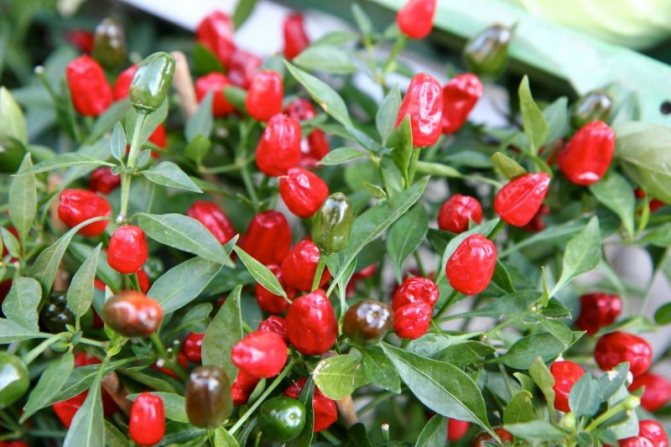

The fruits are kept both fresh and pre-processed. Fresh peppers in the refrigerator, at + 5 ° C, can be stored for several weeks. To extend the shelf life, they are wrapped in cling film, or put in a transparent plastic bag. To extend the period of saving peppers for a longer period, most housewives resort to culinary processing of fruits.
Most often they are:
- dried naturally, or in a dryer;
- cleaned and frozen in portions;
- hot canning;
- pickled in vinegar;
- used for pickles, in combination with herbs.
Important! Pepper fruits Spark can irritate the skin, so when processing them, be sure to use rubber gloves.
Pepper Ogonyok is a worthy replacement and alternative to home flowers. This plant is distinguished not only by its elegant appearance and aesthetics, but also by fragrant fruits that can decorate any dish. It is not difficult to grow it on a windowsill, but in order for the pepper to bear fruit, it needs painstaking care and daily attention.
Pepper seeds


In late summer or early autumn, fruits ripen.
This can be recognized by the bright red color of the pod.
Seeds are extracted from such ripe fruits. They must be laid out and allowed to dry. After which the seeds will be stored for a long time. In the spring they are used for sowing.
The seeds, like the pulp, have a pungent taste.
They can also be added to a dish when cooking or used when preserving. The seeds will add a piquant taste and aroma to the dish.

